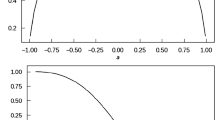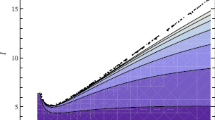Abstract
In the framework of metric \(f(R)\) gravity, we find the dispersion relation for the propagation of tightly wound spiral density waves in the surface of rotating, self-gravitating disks. Also, new Toomre-like stability criteria for differentially rotating disks has been derived for both fluid and stellar disks.






Similar content being viewed by others
References
Binney, J., Tremaine, S.: Galactic Dynamics. Princeton University Press, Princeton (2008)
Capozziello, S., De Laurentis, M.: Phys. Rep. 509, 167 (2011)
Capozziello, S., Cardone, V.F., Troisi, A.: Mon. Not. R. Astron. Soc. 375, 1423 (2007)
Capozziello, S., De Laurentis, M., Odintsov, S.D., Stabile, A.: Phys. Rev. D 83, 064004 (2011)
Carroll, S.M., Duvvuri, V., Trodden, M., Turner, M.S.: Phys. Rev. D 70, 043528 (2004)
Clifton, T., Ferreira Pedro, G., Padilla, A., Skordis, C.: Phys. Rep. 513, 1 (2012)
De Felice, A., Tsujikawa, S.: Living Rev. Relativ. 13, 3 (2010)
Elmegreen, B.G.: Astrophys. J. 737, 10 (2011)
Hohl, F.: Astrophys. J. 168, 343 (1971)
Khoury, J., Weltman, A.: Phys. Rev. Lett. 93, 171104 (2004a)
Khoury, J., Weltman, A.: Phys. Rev. D 69, 044026 (2004b)
Milgrom, M.: Astrophys. J. 338, 121 (1989)
Miller, R.H., Prendergast, K.H., Quirk, W.J.: Astrophys. J. 161, 903 (1970)
Moffat, J.W.: J. Cosmol. Astropart. Phys. 0603, 004 (2006)
Nojiri, S., Odintsov, S.D.: Phys. Rep. 505, 59 (2011)
Noureen, I., Zubair, M.: Astrophys. Space Sci. 356, 103 (2015)
Ostriker, J.P., Peebles, P.J.E.: Astrophys. J. 186, 476 (1973)
Roshan, M., Abbassi, S.: Phys. Rev. D 90, 044010 (2014)
Roshan, M., Abbassi, S.: Astrophys. J. 802(1), 9 (2015)
Seifert, M.D.: Phys. Rev. D 76, 064002 (2007)
Sellwood, J.A.: Mon. Not. R. Astron. Soc. 217, 127 (1985)
Sellwood, J.A.: Rev. Mod. Phys. 86, 1 (2014)
Sellwood, J.A., Evans, N.W.: Astrophys. J. 546, 176 (2001)
Sellwood, J.A., Moore, E.M.: Astrophys. J. 510, 125 (1999)
Sotiriou, T.P., Faraoni, V.: Rev. Mod. Phys. 82, 451 (2010)
Starobinsky, A.A.: JETP Lett. 86, 157 (2007)
Toomre, A.: Astrophys. J. 139, 1217 (1964)
Acknowledgements
This work is supported by Ferdowsi University of Mashhad under Grant No. 100836 (25/05/1393).
Author information
Authors and Affiliations
Corresponding author
Appendices
Appendix A: Potential of a WKB wave in \(f(R)\) gravity
As we mentioned before, locally, a tightly wound spiral wave can be considered as a plan wave. The reason for this similarity is that the pitch angle is very small at every location for tightly wound density waves. It is important to remember that the surface density corresponding to a tightly wound spiral wave is given by (34). In order to find the gravitational potential of this perturbation, without loss of generality, we choose the \(x\) axis to be parallel to \(\mathbf{k}(R_{0})\). Then we use the modified Poisson equation (15) to find the gravitational potential. To do so, we guess the solution to (15) as follows
where \(\lambda\) and \(\epsilon\) are arbitrary real constants. The disk is assumed to be thin and so there is no matter outside (\(z\neq0\)) the disk. Therefore outside the disk the modified Poisson equation (15) can be written down as \(\nabla^{4}\varPhi_{1}-m_{0}^{2}\nabla^{2}\varPhi_{1}=0\). Substituting the potential (65) into this equation, one can easily verify that \(\epsilon=\pm k\). On the other hand, since matter is located at \(z=0\), derivative of \(\varPhi_{1}\) with respect to \(z\) is not continuous. In order to fix the parameter \(\lambda\), we integrate Eq. (32) with respect to \(z\) in the interval \(z=-\xi\) to \(z=+\xi\), where \(\xi\) is a positive constant, and then let \(\xi\rightarrow0\). Therefore, the LHS of (32) gives
note that we have not written those partial derivatives of \(\varPhi_{1}\) which are continuous at \(z=0\), because their integral with respect to \(z\) in the above mentioned interval is zero. The same procedure for the RHS of (32) gives
Taking into account that the tightly wound density wave is \(\varSigma _{1}=\varSigma_{a} e^{i(k x-\omega t)}\), and using the properties of the Dirac delta function, one can show that the second integral in Eq. (67) vanishes. Therefore, Eq. (67) can be simplified as follows
finally, by equating Eq. (66) to (68), we find the relation between \(\lambda\) and \(\varSigma_{a}\) as
as expected, in the limit \(m_{0}^{2}\rightarrow\infty\) and \(\alpha \rightarrow1\), we recover the potential of the tightly wound spiral in Newtonian gravity.
Appendix B: Dispersion relation for stellar disk in \(f(R)\) gravity
In order to study the dynamics of a self-gravitating stellar disk in the framework of metric \(f(R)\) gravity, we need the modified Poisson equation (15) and the collisionless Boltzmann equation (21). Using (21), one can readily derive the Euler and continuity equations, respectively, as follows
where
and \(f\) is the distribution function. Combining Eqs. (70) and (71) with (15) and using the same general technique that we used in Sect. 3.1 to derive the dispersion relation for a fluid disk, we find
where \(\mathfrak{F}\) is the reduction factor. It is the factor by which the response of a stellar disk to an imposed potential is reduced below that of a cold disk (see Binney and Tremaine 2008 for more detail about this factor and the reason for which it appears in the linearized equations), and \(\Delta\) has been defined in (44). Also, one can show that Eqs. (40) and (36) are also applicable for describing a tightly wound density wave in the stellar disk. Therefore, one can find after some algebra that the dispersion relation is
where \(s\) and \(\chi\) are defined as
As in Newtonian gravity, the difference between the dispersion relation of a fluid disk and a stellar one manifest itself in the appearance of the reduction factor in the dispersion relation of the stellar disk. The reduction factor in Newtonian gravity is given by (see Binney and Tremaine 2008 and references therein)
However, a natural question arises here: Does the reduction factor \(\mathfrak{F}\) in metric \(f(R)\) gravity and Newtonian gravity coincide? It is worth mentioning that in obtaining the reduction factor, the Poisson equation is not used (see Appendix \(K\) of Binney and Tremaine 2008 for a full derivation of the reduction factor). On the other hand, at least at the level of field equations, the only difference between Newtonian gravity and the weak field limit of metric \(f(R)\) gravity appears in their Poisson equation. Therefore, we expect that the reduction factor must be the same in both \(f(R)\) and Newtonian gravity. However, we need to treat this conclusion more carefully. In fact for obtaining the reduction factor some assumptions have been done, and one needs to check their consistency in metric \(f(R)\) gravity. This factor has been derived implementing three main assumptions. (1) the given perturbation lies in the WKB approximation. (2) The stellar orbit of stars can be described by the epicycle approximation in which the orbits are nearly circular. (3) The disk is thin and its distribution function is the so-called Schwarzschild distribution function (Binney and Tremaine 2008). The first assumption is satisfied in this work because we are studying tightly wound waves. The main consequence of the second assumption which is necessary for deriving the reduction factor is the relation between \(\sigma_{R}\) and \(\sigma_{\phi}\) in the epicycle approximation as (Binney and Tremaine 2008)
this equation is derived only using the kinematic properties of the nearly circular motion and does not depend on the gravitational theory. Thus this relation can also be used in modified gravity theories including \(f(R)\) gravity. Finally, for the third assumption it is just needed to note that, as we showed in Sect. 2.2, the mathematical form of the collisionless Boltzmann equation in \(f(R)\) and Newtonian gravity is the same. Consequently, one can readily verify that the Schwarzschild distribution function is also a solution for (21). Therefore, we can be sure the reduction factor (76) is also true in metric \(f(R)\) gravity.
Rights and permissions
About this article
Cite this article
Roshan, M., Abbassi, S. Local stability of self-gravitating disks in \(f(R)\) gravity. Astrophys Space Sci 358, 11 (2015). https://doi.org/10.1007/s10509-015-2410-8
Received:
Accepted:
Published:
DOI: https://doi.org/10.1007/s10509-015-2410-8




